I’m a Roxbury girl but African Fashion Week in Boston? New York, even DC maybe but Boston? Boston is not exactly known for its fashion acumen. Of course I’m going but will it turn out to be a hot mess?
Despite my doubts and amidst my curiosity, African Fashion Week was a very real thing sponsored by the House of Nahdra a fierce Ethiopian design house run by a fierce designer on a fashion mission for more than 20 years. (Please note, Nahdra barely looks 20 herself.) “Why not Boston?” Nahdra asked rhetorically when discussing her decision. “Why not have it here instead of waiting for it to come to us?” Accordingly the universe responded insisting she “do it now” rather than later. So Boston’s African Fashion Week happened in November 2016 to a hyped up, sold out, standing room only crowd at Hibernian Hall in Roxbury.
Born and raised in Roxbury herself, Nahdra’s foray into the art world and fashion in particular began when she was very young. She experimented with all types of art including painting on and cutting up new clothes and then putting them back together with safety pins. She appreciated texture and color from an early age as well. She trained initially at the former Burdette School on Boylston Street and also interned with Tunji Dada from Nigeria, another Roxbury denizen. Assisting him was an invaluable experience and soon she started staging her own fashion shows at various colleges and other venues. She learned how to cultivate private clientele and work under pressure in addition to putting a collection together.
For her vision of African Fashion Week, rather than a traditional runway show featuring grim-faced, hoof-footed models, Nahdra set out to create a “cultural experience that would be loving and inviting”. Love is much more than a four-letter word to Nahdra. She hand picked participants (including models and featured designers) promising that the show would be “built on love” and ultimately an atmosphere where “creative souls come together and share their stories”.
The whole concoction took only two months to gel once the vision became clear. The evening would include dancing, music and good food. (Nahdra is a multi-tiered creative, including a dancer and vegan caterer.) Mostly she insisted upon an experience that would be memorable for the audience. Because of her generous spirit, it was also important to open the show up to newer designers and broaden her reach while giving others an opportunity to shine. She was already familiar with some of the designers while several previously unknown to her connected once they heard about the upcoming show. As the well-worn Project Runway adage goes, “one day you’re in and one day you’re out” so inclusion wasn’t instantaneous. Only individual designers (no stores allowed) had to submit photos of work and demonstrate that they could construct their own clothes. The cast of designers hailed from various parts of the Diaspora including Tanzania, Haiti, Trinidad and more, and featured RootXotic, Fabak Fashions, Jahzara Designs, Sharisse Rawlins Designs, FKafrique and the Designer Eye.
The spectrum of models ranged in shape, size and hue. Nahdra steers clear of model agencies, in search of “real people of different sizes and personalities with loving energy”. Because the right energy is so critical to her (“I’m picky,” she says) and it can’t be described in words, she knows right away when someone either has it or lacks it. Some models have worked with her often over the years but she also conducted an open casting call. By show time they had all become family, “inspired by the loving energy and the healing culture” she demands. The models knew it was “our story and our time to share.”
Nahdra sees beauty in many well-known designers and their collections yet she has no favorite she looks to for inspiration. For her own collections she commingles textures and patterns like a “yummy plate of food combining delicious flavors.” She believes there is room in the fashion universe for many types of designers, “like a collage.”
Far from the “hot mess” I was at first concerned it might be, Boston’s premiere annual African Fashion Week was “sizzling hot” with mixes of prints, textures, lengths, and silhouettes that dazzled and wowed the packed house. The show’s traditional African opening included seeking verbal permission to proceed from an elder
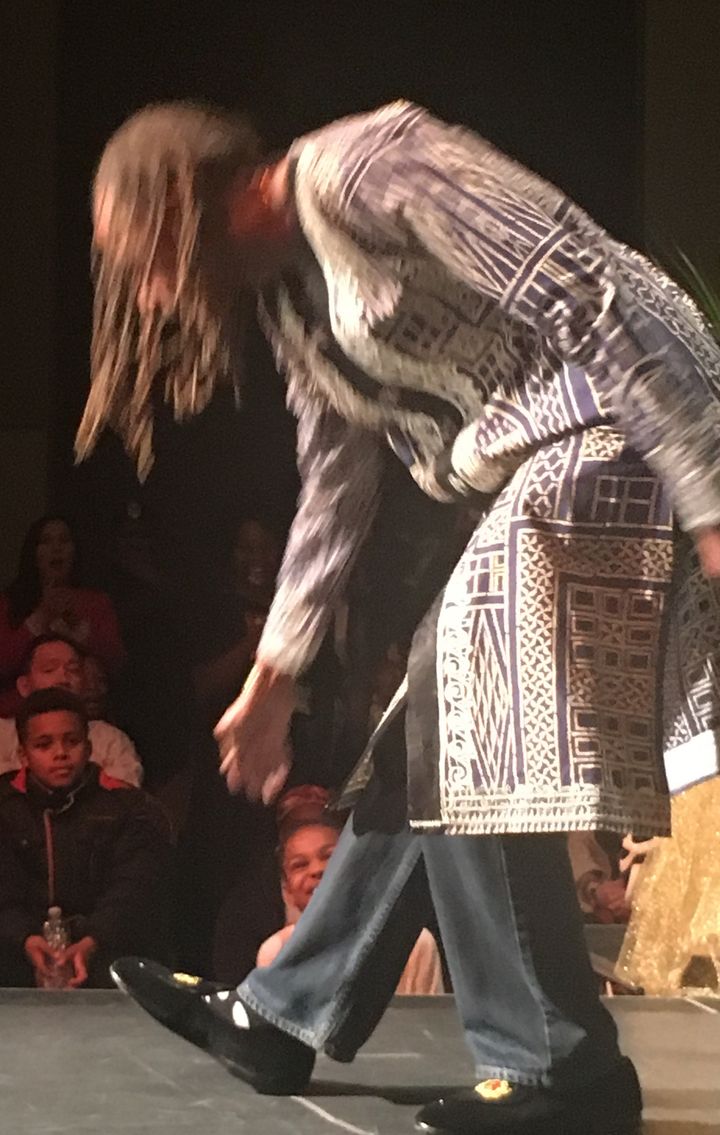
and Senegalese drummers powerfully beating djembes as if it was their last time to do so.
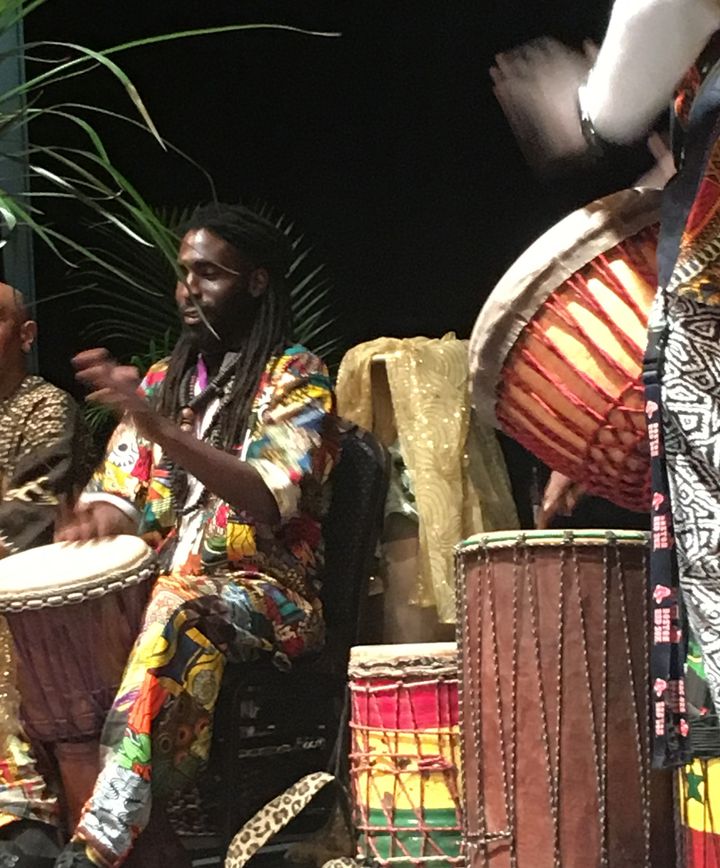
The audience was on high alert that spirits would continue to be elevated. Fashion was not the only item on the menu: there were witty MCs, talented singers, reggae music performers, Burundi dancers, and vigorous youth dancers from Originations. The first models on stage were women with non-crying babies swaddled onto their backs in bright fabrics, sometimes matching their own outifits. This visceral prelude carried viewers straight to the continent.
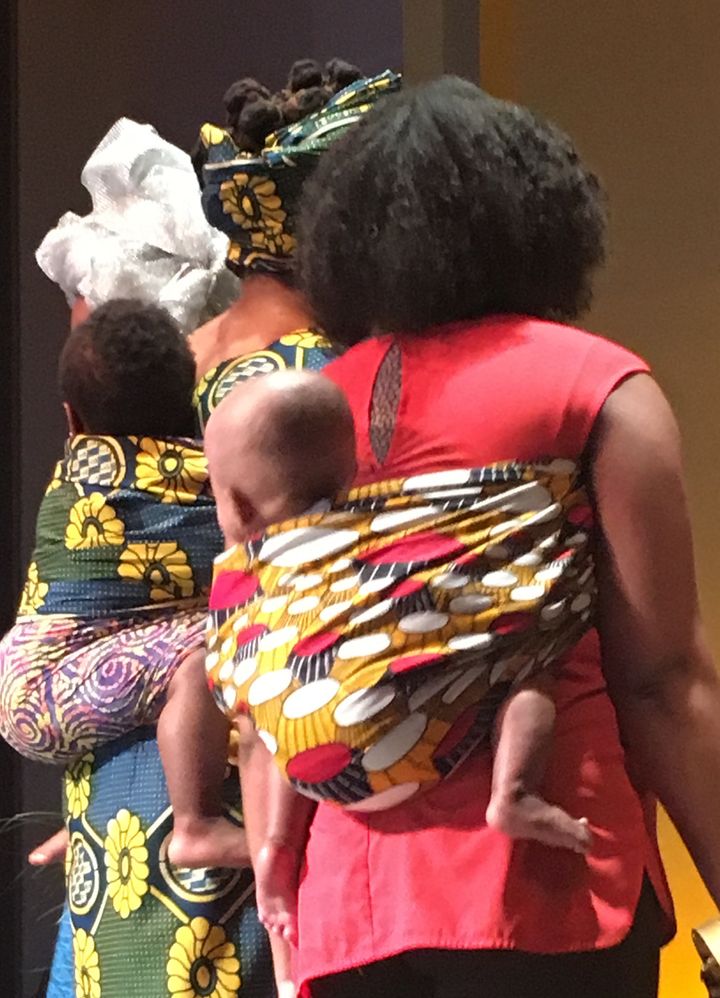
Hair, shoe, and makeup selections all play an important role along with the bodacious sartorial narrative.
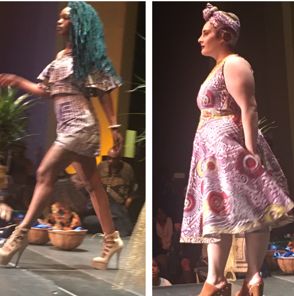
Nahdra uses tribal markings for her own makeup as well as on her models.
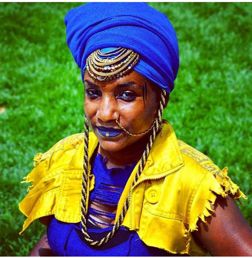
She has always loved such markings as her father, from the Northern Ethiopia Tigre tribe, is adorned with them. “The markings’ symbolism speak volumes,” she says. “For example the circles represent 360 degrees, a complete life, eternal life; the number 11 is a spiritual gateway.” And the vibrant colors that competed for attention on the runway? “They all have meaning but blue especially is healing so lots of blue.”
The silhouettes kept coming in forms of chandelier velour pants, lantern sleeves, mermaid dresses, jodhpurs, ribbons of flowing fabric, vests, layered layers, paneled jumpsuits, fabric and pattern merging and more. Both men and women’s fashions were featured simultaneously and there was also a children’s scene that included Nahdra’s daughter as a model.
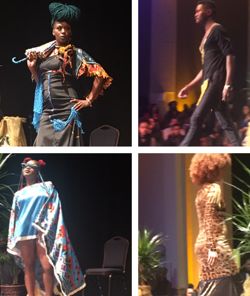
The adult show was almost overshadowed by the luminous children’s portion, which presented outfits created by a very young designer. (Hint hint: next year the children need their own show!) The youth models exuded confidence, flair and, my mother’s term - “pizzazz,” every time they graced the runway.
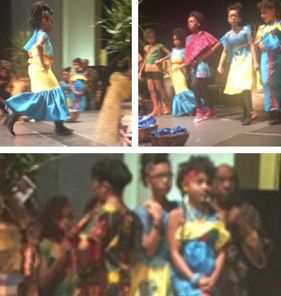
African Fashion Week was beyond successful and in keeping with Nahdra’s food metaphor, I can’t wait for next year’s “style banquet” delivered from the Continent via Roxbury.